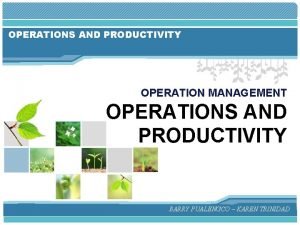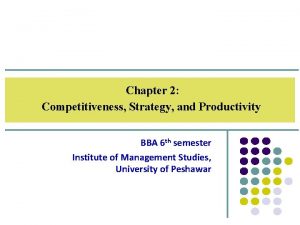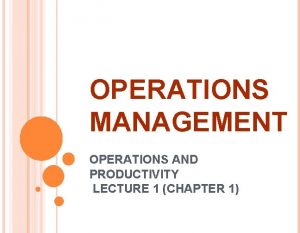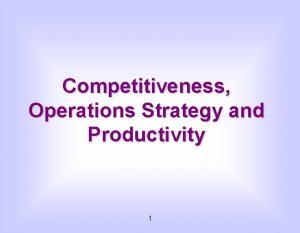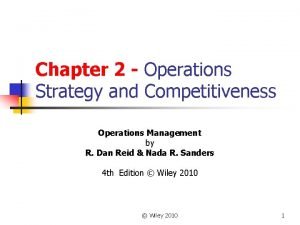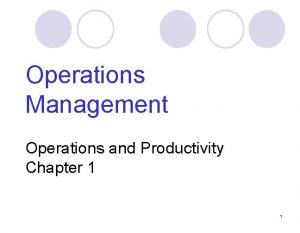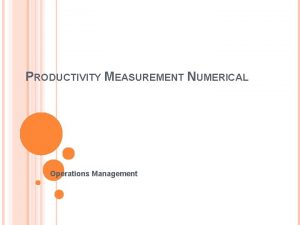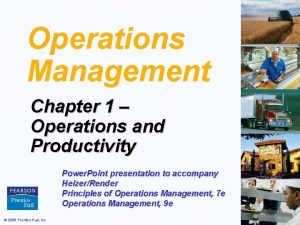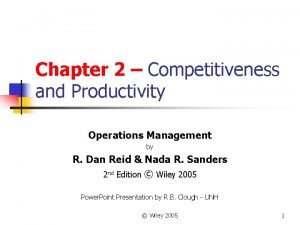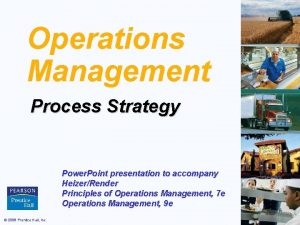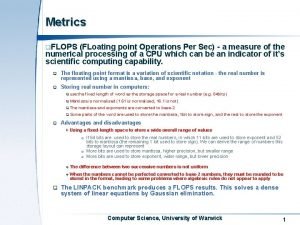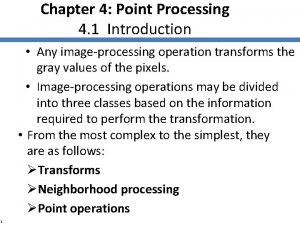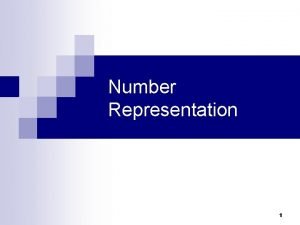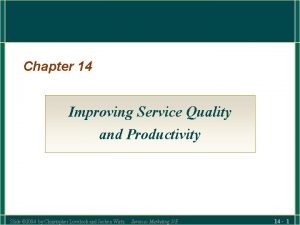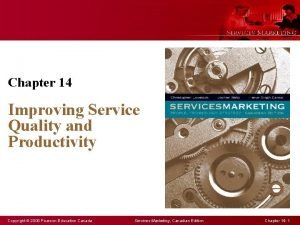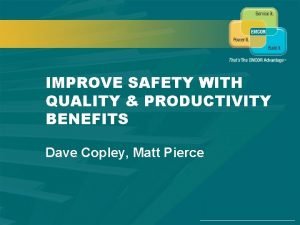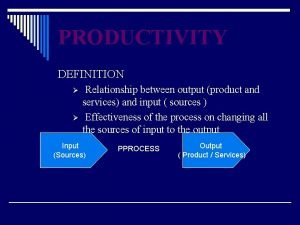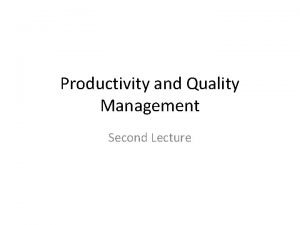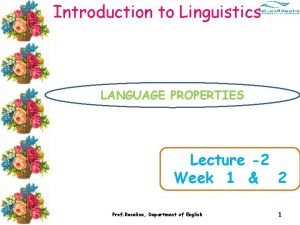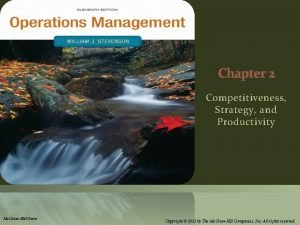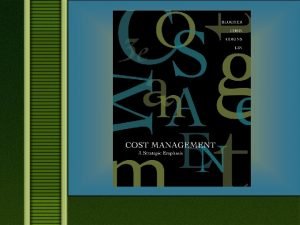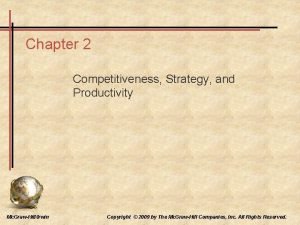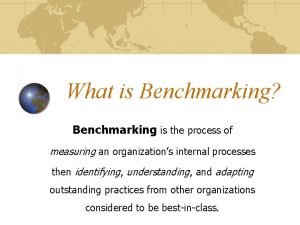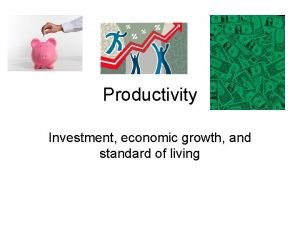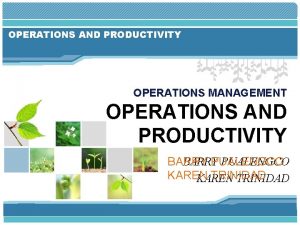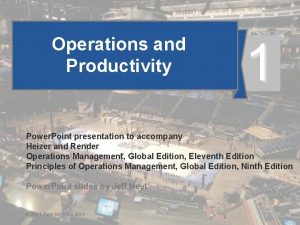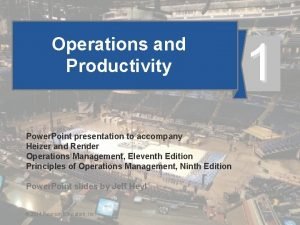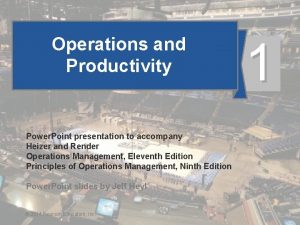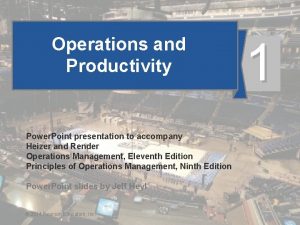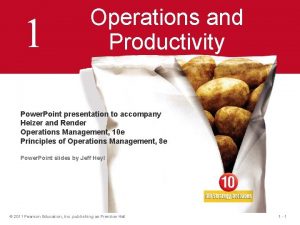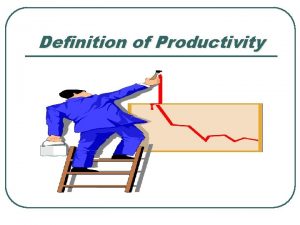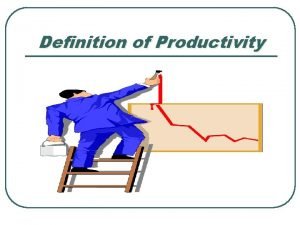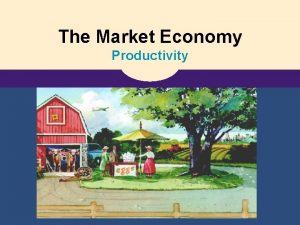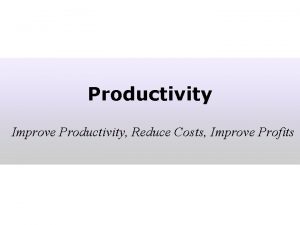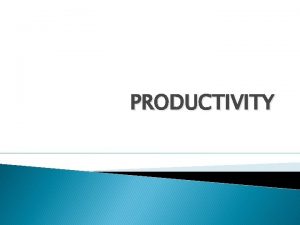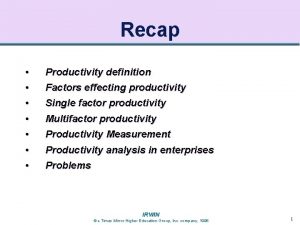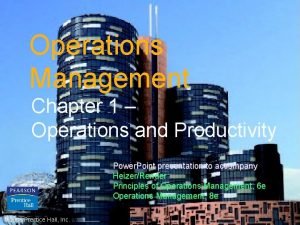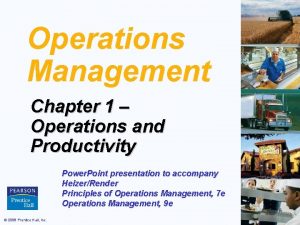1 Operations and Productivity Power Point presentation to








































- Slides: 40

1 Operations and Productivity Power. Point presentation to accompany Heizer and Render Operations Management, 10 e Principles of Operations Management, 8 e Power. Point slides by Jeff Heyl © 2011 Pearson Education, Inc. publishing as Prentice Hall 2 -1

What Is Operations Management? Production is the creation of goods and services Operations management (OM) is the set of activities that create value in the form of goods and services by transforming inputs into outputs © 2011 Pearson Education, Inc. publishing as Prentice Hall 2 -2

Organizing to Produce Goods and Services u Essential functions: 1. 2. Marketing – generates demand Production/operations – creates the product 3. Finance/accounting – tracks how well the organization is doing, pays bills, collects the money © 2011 Pearson Education, Inc. publishing as Prentice Hall 2 -3

Organizational Charts Commercial Bank Operations Finance Marketing Teller Scheduling Check Clearing Collection Transaction processing Facilities design/layout Vault operations Maintenance Security Investments Security Real estate Loans Commercial Industrial Financial Personal Mortgage Accounting Auditing Trust Department Figure 1. 1(A) © 2011 Pearson Education, Inc. publishing as Prentice Hall 2 -4

Organizational Charts Airline Operations Ground support equipment Maintenance Ground Operations Facility maintenance Catering Flight Operations Crew scheduling Flying Communications Dispatching Management science Finance/ accounting Accounting Payables Receivables General Ledger Finance Cash control International exchange © 2011 Pearson Education, Inc. publishing as Prentice Hall Marketing Traffic administration Reservations Schedules Tariffs (pricing) Sales Advertising Figure 1. 1(B) 2 -5

Organizational Charts Manufacturing Operations Facilities Construction; maintenance Production and inventory control Scheduling; materials control Quality assurance and control Supply-chain management Manufacturing Tooling; fabrication; assembly Design Product development and design Detailed product specifications Industrial engineering Efficient use of machines, space, and personnel Finance/ accounting Disbursements/ credits Receivables Payables General ledger Funds Management Money market International exchange Capital requirements Stock issue Bond issue and recall Marketing Sales promotion Advertising Sales Market research Process analysis Development and installation of production tools and equipment © 2011 Pearson Education, Inc. publishing as Prentice Hall Figure 1. 1(C) 2 -6

Ten Critical Decisions Ten Decision Areas 1. Design of goods and services 2. Managing quality 3. Process and capacity design 4. Location strategy 5. Layout strategy 6. Human resources and job design 7. Supply-chain management 8. Inventory, MRP, JIT 9. Scheduling 10. Maintenance © 2011 Pearson Education, Inc. publishing as Prentice Hall Chapter(s) 5 6, Supplement 6 7, Supplement 7 8 9 10 11, Supplement 11 12, 14, 16 13, 15 17 Table 1. 2 2 -7

The Critical Decisions 1. Design of goods and services u What good or service should we offer? u How should we design these products and services? 2. Managing quality u How do we define quality? u Who is responsible for quality? Table 1. 2 (cont. ) © 2011 Pearson Education, Inc. publishing as Prentice Hall 2 -8

The Critical Decisions 3. Process and capacity design u What process and what capacity will these products require? u What equipment and technology is necessary for these processes? 4. Location strategy u Where should we put the facility? u On what criteria should we base the location decision? Table 1. 2 (cont. ) © 2011 Pearson Education, Inc. publishing as Prentice Hall 2 -9

The Critical Decisions 5. Layout strategy u How should we arrange the facility? u How large must the facility be to meet our plan? 6. Human resources and job design u How do we provide a reasonable work environment? u How much can we expect our employees to produce? Table 1. 2 (cont. ) © 2011 Pearson Education, Inc. publishing as Prentice Hall 2 - 10

The Critical Decisions 7. Supply-chain management u Should we make or buy this component? u Who should be our suppliers and how can we integrate them into our strategy? 8. Inventory, material requirements planning, and JIT u How much inventory of each item should we have? u When do we re-order? Table 1. 2 (cont. ) © 2011 Pearson Education, Inc. publishing as Prentice Hall 2 - 11

The Critical Decisions 9. Intermediate and short–term scheduling u Are we better off keeping people on the payroll during slowdowns? u Which jobs do we perform next? 10. Maintenance u How do we build reliability into our processes? u Who is responsible for maintenance? Table 1. 2 (cont. ) © 2011 Pearson Education, Inc. publishing as Prentice Hall 2 - 12

Characteristics of Goods u Tangible product u Consistent product definition u Production usually separate from consumption u Can be inventoried u Low customer interaction © 2011 Pearson Education, Inc. publishing as Prentice Hall 2 - 13

Characteristics of Service u Intangible product u Produced and consumed at same time u Often unique u High customer interaction u Inconsistent product definition u Often knowledge-based u Frequently dispersed © 2011 Pearson Education, Inc. publishing as Prentice Hall 2 - 14

Goods and Services Automobile Computer Installed carpeting Fast-food meal Restaurant meal/auto repair Hospital care Advertising agency/ investment management Consulting service/ teaching Counseling 100% | 75 | 50 | 25 | Percent of Product that is a Good © 2011 Pearson Education, Inc. publishing as Prentice Hall 0 | 25 | 50 | 75 | 100% | Percent of Product that is a Service 2 - 15

Productivity Challenge Productivity is the ratio of outputs (goods and services) divided by the inputs (resources such as labor and capital) The objective is to improve productivity! Important Note! Production is a measure of output only and not a measure of efficiency © 2011 Pearson Education, Inc. publishing as Prentice Hall 2 - 16

The Economic System Inputs Transformation Outputs Labor, capital, management The U. S. economic system transforms inputs to outputs at about an annual 2. 5% increase in productivity per year. The productivity increase is the result of a mix of capital (38% of 2. 5%), labor (10% of 2. 5%), and management (52% of 2. 5%). Goods and services Feedback loop Figure 1. 6 © 2011 Pearson Education, Inc. publishing as Prentice Hall 2 - 17

Productivity = Units produced Input used u Measure of process improvement u Represents output relative to input u Only through productivity increases can our standard of living improve © 2011 Pearson Education, Inc. publishing as Prentice Hall 2 - 18

Productivity Calculations Labor Productivity Units produced Productivity = = Labor-hours used 1, 000 250 = 4 units/labor-hour One resource input single-factor productivity © 2011 Pearson Education, Inc. publishing as Prentice Hall 2 - 19

Multi-Factor Productivity Output Productivity = Labor + Material + Energy + Capital + Miscellaneous u Also known as total factor productivity u Output and inputs are often expressed in dollars Multiple resource inputs multi-factor productivity © 2011 Pearson Education, Inc. publishing as Prentice Hall 2 - 20

Collins Title Productivity Old System: Staff of 4 works 8 hrs/day Payroll cost = $640/day 8 titles/day Overhead = $400/day 8 titles/day Old labor = productivity 32 labor-hrs © 2011 Pearson Education, Inc. publishing as Prentice Hall 2 - 21

Collins Title Productivity Old System: Staff of 4 works 8 hrs/day Payroll cost = $640/day 8 titles/day Overhead = $400/day 8 titles/day Old labor = productivity 32 labor-hrs =. 25 titles/labor-hr © 2011 Pearson Education, Inc. publishing as Prentice Hall 2 - 22

Collins Title Productivity Old System: Staff of 4 works 8 hrs/day Payroll cost = $640/day New System: 14 titles/day 8 titles/day Overhead = $400/day Overhead = $800/day 8 titles/day Old labor = productivity 32 labor-hrs =. 25 titles/labor-hr 14 titles/day New labor = productivity 32 labor-hrs © 2011 Pearson Education, Inc. publishing as Prentice Hall 2 - 23

Collins Title Productivity Old System: Staff of 4 works 8 hrs/day Payroll cost = $640/day New System: 14 titles/day 8 titles/day Overhead = $400/day Overhead = $800/day 8 titles/day Old labor = productivity 32 labor-hrs =. 25 titles/labor-hr 14 titles/day New labor = =. 4375 titles/labor-hr productivity 32 labor-hrs © 2011 Pearson Education, Inc. publishing as Prentice Hall 2 - 24

Collins Title Productivity Old System: Staff of 4 works 8 hrs/day Payroll cost = $640/day New System: 14 titles/day 8 titles/day Overhead = $400/day Overhead = $800/day 8 titles/day Old multifactor = productivity $640 + 400 © 2011 Pearson Education, Inc. publishing as Prentice Hall 2 - 25

Collins Title Productivity Old System: Staff of 4 works 8 hrs/day Payroll cost = $640/day New System: 14 titles/day 8 titles/day Overhead = $400/day Overhead = $800/day 8 titles/day Old multifactor = =. 0077 titles/dollar productivity $640 + 400 © 2011 Pearson Education, Inc. publishing as Prentice Hall 2 - 26

Collins Title Productivity Old System: Staff of 4 works 8 hrs/day Payroll cost = $640/day New System: 14 titles/day 8 titles/day Overhead = $400/day Overhead = $800/day 8 titles/day Old multifactor = =. 0077 titles/dollar productivity $640 + 400 14 titles/day New multifactor = productivity $640 + 800 © 2011 Pearson Education, Inc. publishing as Prentice Hall 2 - 27

Collins Title Productivity Old System: Staff of 4 works 8 hrs/day Payroll cost = $640/day New System: 14 titles/day 8 titles/day Overhead = $400/day Overhead = $800/day 8 titles/day Old multifactor = =. 0077 titles/dollar productivity $640 + 400 14 titles/day New multifactor = =. 0097 titles/dollar productivity $640 + 800 © 2011 Pearson Education, Inc. publishing as Prentice Hall 2 - 28

Change in productivity 8 titles/day Old multifactor = =. 0077 titles/dollar productivity $640 + 400 14 titles/day New multifactor = =. 0097 titles/dollar productivity $640 + 800 Change in productivity =. 0097 -. 0077 =. 0020 2 - 29

Change in productivity as a % Old System: Old MF-productivity =. 0077 titles/dollar New System: New multifactor productivity =. 0097 titles/dollar Change in productivity as a % = = 25. 97% 2 - 30

2 Operations Strategy in a Global Environment Power. Point presentation to accompany Heizer and Render Operations Management, 10 e Principles of Operations Management, 8 e Power. Point slides by Jeff Heyl © 2011 Pearson Education, Inc. publishing as Prentice Hall 2 - 31

Developing Missions and Strategies Mission statements tell an organization where it is going The Strategy tells the organization how to get there © 2011 Pearson Education, Inc. publishing as Prentice Hall 2 - 32

Mission u Mission - where are you going? u Organization’s purpose for being u Answers ‘What do we provide society? ’ u Provides boundaries and focus © 2011 Pearson Education, Inc. publishing as Prentice Hall 2 - 33

Factors Affecting Mission Philosophy and Values Profitability and Growth Environment Mission Customers Public Image Benefit to Society © 2011 Pearson Education, Inc. publishing as Prentice Hall 2 - 34

Strategic Process Organization’s Mission Functional Area Missions Marketing Operations © 2011 Pearson Education, Inc. publishing as Prentice Hall Finance/ Accounting 2 - 35

Strategy u Action plan to achieve mission u Functional areas have strategies u Strategies exploit opportunities and strengths, neutralize threats, and avoid weaknesses © 2011 Pearson Education, Inc. publishing as Prentice Hall 2 - 36

Strategies for Competitive Advantage u Differentiation – better, or at least different u Cost leadership – cheaper u Response – rapid response © 2011 Pearson Education, Inc. publishing as Prentice Hall 2 - 37

Process Design Variety of Products High Moderate Process-focused Mass Customization JOB SHOPS Customization at high Volume (Print shop, emergency room, machine shop, (Dell Computer’s PC, fine-dining Repetitive (modular) cafeteria) restaurant) focus ASSEMBLY LINE (Cars, appliances, TVs, fast-food Product focused restaurants) CONTINUOUS (Steel, beer, paper, bread, institutional kitchen) Low © 2011 Pearson Education, Inc. publishing as Prentice Hall Moderate Volume High 2 - 38

Job shop v. Assembly Line Job shop u Labor intensive Assembly line u Capital intensive u Highly skilled labor u Low/medium skill u General purpose machines u Specialized/automated machines u Flexible process flow u Standard process flow u Customized products u Standard product line u Made to order u Made to stock © 2011 Pearson Education, Inc. publishing as Prentice Hall 2 - 39

Production and Inventory Strategies u Make-to-order strategy: A strategy used by manufactures that make products to customer specifications in low volume. u Assemble-to-order strategy: A strategy for producing a wide variety of products from relatively few assemblies and components after the customer orders are received. u Make-to-stock strategy: A strategy that involves holding items in stock for immediate delivery, thereby minimizing customer delivery times. 2 - 40
 Operation and productivity
Operation and productivity Why is productivity important
Why is productivity important The ten critical decisions of operations management include
The ten critical decisions of operations management include Productivity and competitiveness in operations management
Productivity and competitiveness in operations management Productivity and competitiveness in operations management
Productivity and competitiveness in operations management Operation and productivity chapter 1
Operation and productivity chapter 1 Multifactor productivity in operations management
Multifactor productivity in operations management Labor productivity formula
Labor productivity formula Multifactor productivity operations management
Multifactor productivity operations management Topics for powerpoint presentation for class 4
Topics for powerpoint presentation for class 4 Power point presentation design west vancouver
Power point presentation design west vancouver Power traiangle
Power traiangle Power bi training powerpoint
Power bi training powerpoint Point point power
Point point power Fetal brow
Fetal brow Vertex presentation and cephalic presentation
Vertex presentation and cephalic presentation Process focus strategy
Process focus strategy Hub and spoke vs point to point
Hub and spoke vs point to point Floating-point operations per second
Floating-point operations per second Point processing in digital image processing
Point processing in digital image processing Point processing operations
Point processing operations Explain floating point arithmetic operations with example
Explain floating point arithmetic operations with example Neighborhood processing
Neighborhood processing Solar power satellites and microwave power transmission
Solar power satellites and microwave power transmission Actual power and potential power
Actual power and potential power Unit of dispersive power
Unit of dispersive power Prayer points for power and authority
Prayer points for power and authority Advantages and disadvantages presentation
Advantages and disadvantages presentation Improving service quality and productivity
Improving service quality and productivity Service quality and productivity
Service quality and productivity Safety quality productivity cost
Safety quality productivity cost Production and productivity definition
Production and productivity definition Define productivity
Define productivity Healthy food healthy mind journal
Healthy food healthy mind journal Productivity and displacement in language
Productivity and displacement in language Competitiveness strategy and productivity
Competitiveness strategy and productivity Managing productivity and marketing effectiveness
Managing productivity and marketing effectiveness Chapter 2 competitiveness strategy and productivity
Chapter 2 competitiveness strategy and productivity What is benchmarking
What is benchmarking Productivity and standard of living
Productivity and standard of living Lam employment absence and productivity scale
Lam employment absence and productivity scale
